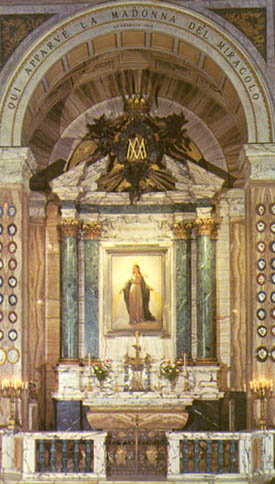Tuesday, May 24
Side Altars Today: Restoring A Lost Balance
With a renewed appreciation of traditional architecture, there is often (though not always) a return to the installation of side altars: side altars are beneficial to the of hierarchy and design integral to traditional ecclesiastical architecture. However, this is not a “good enough” reason: “the merely decorative erection of several altars in a church must be entirely avoided.”[1] In light of the great lengths which have been taken to soundly demonstrate the legitimacy of their construction, and with deference to liturgical law, a more coherent and motivational impetus for the recovery of the side altar is absolutely necessary.
Once again, recall the stark division between popular piety and the liturgical life of the Church which was bemoaned at the commencement of this consideration. Indeed, it is not uncommon for some liturgists to remark that popular piety “indicates a deficiency in the Liturgy.” The side altar offers a proven solution to this division.
The Second Vatican Council declared that the “sacred liturgy does not exhaust the entire activity of the Church.”[2] Additionally, the Church must also preach Faith and penance, prepare faithful for sacraments, teach, and encourage works of charity, piety, and apostolate. Speaking of these works of piety, the Council continues, “the popular devotions of the Christian people are to be highly commended… These devotions should be so drawn up that… accord with the sacred liturgy, are in some fashion derived from it, and lead people to it, since, in fact, the liturgy by its very nature far surpasses any of them.”[3] In other words, popular devotions are not contrary to the Liturgy, but serve the Liturgy. If such is the case, popular piety must be consummated in the Sacred Liturgy of the Mass, “the summit toward which the activity of the Church is directed and the font from which all her power flows.”[4] Such a liturgical consummation of popular piety is precisely the reason that liturgical feasts honor the Saints, the dead, devotions to Mary (such as Fatima and Lourdes), the Sacred Heart, and Holy Name.
Liturgical feasts alone, however, have not been sufficient to attain the synthesis of popular piety and liturgy which the Church once enjoyed. The side altar’s importance, then, is to be a synthesis of liturgy and devotion. When a priest celebrates a Mass without a congregation on a side altar in a public church, he can no longer be accused of making the Mass into a private devotion—the celebration is no longer “private”! When the highest form of intercessory prayer is publicly acknowledged, through the dedication and use of side altars, to be the celebration of the Mass for a particular intention, the liturgy becomes immediately more relevant to the lives of many who may not have connected their private worries and prayers with the Church’s public, perhaps aesthetically impersonal, liturgy. When devotion to the Holy Souls culminates in the Sacrifice of the Mass, not only is the proper place of indulgences relative to the Mass emphasized, but this doctrine no longer remains the private reserve of a few educated Catholics; further, when aligned with Liturgy, aberrations in devotion to the Holy Souls are more easily avoided. When the highest act of praying, petitioning, or thanking a saint necessarily occurs within the context of the Liturgy and liturgical furnishings such as the altar, devotion to the saint necessarily becomes Christocentric. The communion of saints is therefore highlighted not as the personal occupation of a few dedicated faithful, but instead as a real and public exchange in which the entire Church is involved. Any particular devotion, when contextualized by the side altar, is much more naturally seen to flow from and return to the liturgical life of the Church.
The earliest houses of worship had a single altar, and the primary importance of that major altar has remained through Christianity. Nonetheless, as priestly piety, intercessory prayer, devotion to the Holy Souls, and the cult of the saints all found their culmination in the celebration of the liturgy, the construction of additional minor altars became necessary. The post-conciliar Church has witnessed a stunning separation of these forms of piety from the liturgy; in fact, they no longer constitute an important part of the spiritual lives of many, many Catholics. New liturgical norms have made the construction of side altars more difficult, wrongly giving many the impression that the construction of side altars has in fact been forbidden. Despite these difficulties, however, a recovery of side altars and their use is necessary to work towards a restoration of appropriate balance between popular devotion and liturgy. As a recent pilgrim notd, “The memory and emotions of praying at the altar of St. Elizabeth Ann
Seton will remain with me forever." Our Churches should be so lucky as to enkindle such Liturgically-centered, Christocentric Devotion
Popular devotion…which is properly contextualized and Christocentric,
which proceeds from the liturgy and culminates in the liturgy, which follows the vision of Vatican II,
which belongs to the organic tradition of Christian practice and architecture,

... not like this:

finis...
[1] Ceremonial of Bishops, “Dedication of an Altar,” para. 7
[2] Sacrosanctum Concilium, para. 9
[3] Sacrosanctum Concilium, para. 13
[4] Sacrosanctum Concilium, para. 10












